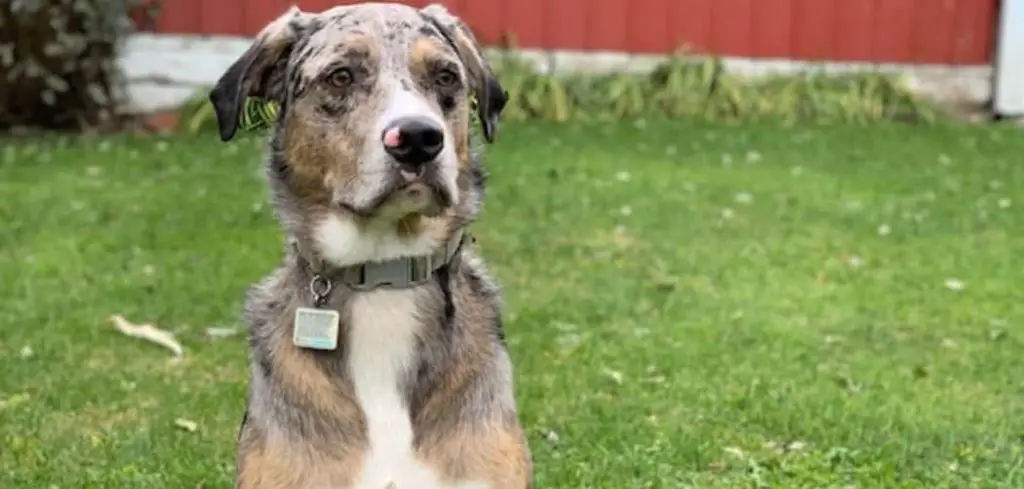Noticing that your dog is breathing abnormally while still eating normally can be alarming.
Even though your dog appears healthy and maintains a good appetite, subtle breathing changes may signal underlying issues that need attention.
This guide outlines the common reasons why a dog may not breath properly but still eating, what you can do at home, and when to seek veterinary help.
Table of Contents
Dog Not Breathing Properly but Eating: Why It Happens
Dogs that are not breathing properly but continue eating may have early-stage or mild respiratory or cardiovascular problems. Conditions such as heart disease, airway inflammation, mild infections, or early heartworm disease can create subtle breathing changes without affecting appetite.
Since dogs are naturally adept at hiding discomfort, they may continue eating normally while their respiratory system is under stress.
Observing for subtle signs like shallow inhalations, wheezing, or slightly irregular breathing can help you detect problems early and seek timely veterinary care.

Dog Not Breathing Properly but Eating: Common Causes
Early-Stage Heart Disease
Heart disease can develop gradually, and early stages often show minimal outward symptoms.
A dog’s heart may struggle to pump blood efficiently, leading to fluid buildup in the lungs and subtle labored breathing.
Dogs with early-stage heart disease may continue eating normally and appear energetic. Small breeds are particularly susceptible to valve disease, which can worsen over time.
Detecting heart disease early allows for treatments that slow progression and improve quality of life, preventing serious complications.
Related: Dog Not Breathing Properly and Coughing (Here’s why)
Mild Respiratory Infections
Some respiratory infections cause coughing or shallow breathing while leaving appetite unaffected.
Viral or bacterial infections can inflame the upper or lower airways, causing subtle breathing changes. Dogs may maintain normal eating and play behavior while experiencing mild congestion or occasional coughing.
If left untreated, these infections can worsen, potentially leading to pneumonia or more serious respiratory issues.
Early observation and veterinary assessment are key to preventing complications.
Allergies
Allergies or exposure to irritants can affect breathing without influencing appetite.
Pollen, dust, smoke, or chemical fumes can irritate a dog’s airways, causing mild inflammation.
Dogs may breathe slightly faster or noisily but continue eating normally, masking the issue. Other signs may include sneezing, pawing at the nose, or mild wheezing.
Persistent irritation requires veterinary evaluation to prevent respiratory distress, particularly if the dog lives in an environment with recurring allergens.
Collapsing Trachea
A collapsing trachea can occur subtly and often goes unnoticed while dogs continue normal activities.
Common in small breeds, the cartilage rings in the trachea weaken, causing partial airway collapse.
Dogs may produce a distinctive honking cough or show mild labored breathing, particularly when excited, yet still eat normally.
Early recognition allows for management with medication, harness adjustments, and lifestyle changes to reduce stress on the airway and prevent worsening symptoms.
Mild Heartworm Disease
Early heartworm infection can subtly affect breathing while leaving appetite unaffected.
Heartworms residing in the heart and lungs can gradually impair respiratory function. Dogs may show slightly increased respiratory rate or mild coughing without reducing food intake.
Since symptoms can be hidden, owners may not notice the issue until the disease progresses and causes severe heart and lung damage.
Preventive measures and early testing are critical to protect your dog from life-threatening complications.
Obesity and Poor Fitness
Overweight or deconditioned dogs may exhibit mild breathing changes without affecting their eating habits.
Extra body weight puts strain on the lungs and heart, causing shallow or faster-than-normal breathing during activity.
Dogs may eat normally and seem healthy, but their breathing may indicate stress on the respiratory system.
Observing exercise tolerance, gradual weight loss, and improved fitness can reduce strain and improve overall respiratory efficiency.
Related: Dog Not Moving but Breathing (Here’s why)
What to Do If Your Dog Is Not Breathing Properly but Eating
Careful observation is the first step. Monitor your dog’s breathing for rate, depth, and regularity, and compare it to their usual patterns.
Record any changes, including mild wheezing, rapid breaths, or short pauses in inhalation or exhalation.
Create a calm environment, free from smoke, strong cleaning chemicals, or perfumes that could irritate the airway. Remove tight collars or harnesses to prevent additional pressure on the neck and throat.
Watch for subtle signs such as coughing, slight fatigue during play, or altered posture when resting. Keep a daily log of observations to help your veterinarian identify patterns and potential underlying issues.
Ensure your dog has easy access to water and food, but avoid forcing consumption. Providing a quiet, comfortable resting space supports your dog’s overall respiratory health while minimizing stress and exertion.
When to Call or Visit Your Vet
Prompt veterinary attention is necessary when subtle breathing issues are present.
Seek care if your dog shows persistent shallow breathing, occasional coughing, or mild wheezing that does not resolve. Rapid or labored breathing at rest, shortness of breath, or blue-tinged gums are signs of oxygen deprivation and require immediate evaluation.
Notice if your dog tires easily, becomes anxious, or experiences fainting episodes, which can indicate underlying heart or respiratory disease. Early intervention allows for diagnosis and treatment before conditions worsen.
Even if your dog appears normal otherwise, subtle changes in breathing should never be ignored. Early detection can prevent progression and improve quality of life.
Read more: Dog Not Breathing (What it could mean)
Key Takeaway
A dog not breathing properly but eating normally may still be experiencing underlying heart, lung, or airway problems.
Conditions like early heart disease, mild infections, airway collapse, allergies, or heartworm infection can all cause subtle changes in breathing.
Observing your dog carefully, documenting changes, and seeking veterinary care promptly are essential steps to prevent complications and ensure your dog’s long-term health.
Staying attentive and proactive helps your dog maintain normal activity, a healthy appetite, and safe breathing.
